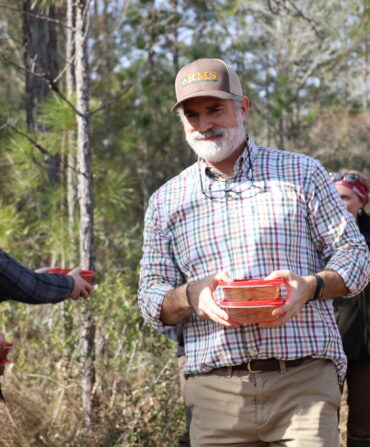Walker Babington looks like he came straight out of a vaudeville tent, the curling ends of his thick mustache bookending a mischievous smile. That theatricality extends to the rest of the New Orleans artist’s life. Babington is a working stuntman, trained to fall, fight, or catch on fire. And he’s a self-taught sculptor whose giant Seussian structures—previously spotted only at such festivals as Burning Man and Mardi Gras—now have Smithsonian street cred.

Babington says he’s always been “extra.” While he was growing up in Maryland, “my parents saw potential success but also worried I might end up in jail,” he recalls with a laugh. After a few years globe-trotting, in 2011 he enrolled in a Seattle stunt school and has since landed roles in such films as The Magnificent Seven and stunt-doubled for the likes of Sam Rockwell. He also picked a home base. “When I was traveling, every time I hit New Orleans, I felt roots grow.”

There, in 2015, Babington began developing what he calls his “large-scale, fantastical symbolist folk art.” But his fascination with building started long before. “I’ve been collecting reclaimed materials and reassembling them into figures since I was four,” he says. Burning Man, the avant-garde arts festival in Nevada, “allowed me to envision taking it to a larger scale.”
His first bigger piece, a rendition of the Russian folklore figure Baba Yaga, included a twenty-foot-high “witch house” held aloft by legs of corrugated metal feathers and, he explains, “oystershell ‘chicken skin’ plastered on.” Babington debuted it at the T-Bois Blues Festival in Louisiana, and an art collector later commissioned a similar one. His reclaimed materials resonated. “I’m always on the hunt,” he says. “The side of the road, the banks of the Mississippi, local architectural salvage stores, and of course dumpster diving. I’ve also got an arrangement with the local scrapyard, where I slip the manager on duty a bone and scavenge.”
He has another secret weapon, too: his wife, the filmmaker, producer, and artist Shana Betz, whom he met and married in New Orleans. “As a visual storyteller, I like to act as a prompt for Walker to support the narrative behind each sculpture,” Betz explains. “It creates a strong root system as he refines his sketches.”
That collaboration played out in his largest piece yet, Burden of the Beast, a thirty-two-foot-tall bison bisected by a ramshackle house. The curved ribbons of wood that make up the animal’s fur came from homes ravaged by Hurricane Ida in 2021. “I’d been sketching the bison for ten years,” Babington says. “The idea is a bayou house, wrecked by water. Memories sank into the floorboards, and they convinced the house to rise up, on the back of this bison. Even if your home is destroyed, home still exists.”

With the help of assistants, Babington assembles his sculptures in sections. For 2023’s Burning Man, they drove Burden there in pieces to erect it on-site. During a panel, Babington and Betz caught the attention of Carrie Spencer, a curator at the Smithsonian affiliated Hermitage Museum & Gardens in Norfolk, Virginia. “He was speaking about relevant issues, like rising sea levels—a challenge we deal with here in Norfolk,” Spencer recalls. “I saw [the sculpture] after, and it’s so layered and dynamic. When you add in that underlying message, I knew it was perfect for our museum.” Now Burden of the Beast sits on the Hermitage’s front lawn, where it will remain until October. The museum is also exhibiting Babington’s Zozobot, a giant Harlequin robot clown with a fiberglass face and a massive telescope, a comment on artificial intelligence.
Closer to home, Tulane University commissioned Babington’s Kaleidosophia for its campus library. The tree-trunk-thick kaleidoscope, made of discarded brass, antique metal, and colored glass, features a crank and a brass pump that produce bursts of feathers, and swirling vintage maps from Tulane’s historic city collection. And soon, libraries may contain his work in a different medium: He’s illustrating a series of children’s books, inspired by his seven-year-old daughter, Willa. “Everything I do has a childhood element to it,” he explains. “It’s colorful, weird, and a little slanted.”








